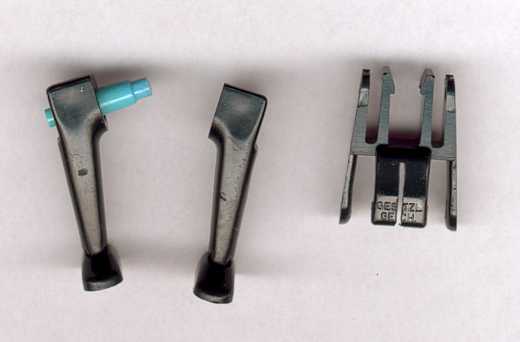Again, I'm not saying it was a very good idea, seperate legs. But there are many dolls and pupets that do have that feature. So it is not very strange for playmobil to at least consider that feature.
And sure, LEGO has baseplates that stabilise their minifigures. But the first playmobil came out with baseplates for klickies, didn't they?
Furthermore Barbie/barbie like dolls also have separetely moving legs. And they have a lot of trouble standing.
This is a drawing of a prototype. That doesn't mean it is already prefect. After all, the buttons on the shirt were dropped as well.
About the drawing, let walk through that systematically.
The first drawing on the left has a vertical seam across the middle. Why draw that? It is a construction drawing. Why put lines in it that have no meaning of function? You just don't do that.
Picture number 2 from the left shows one leg up and one leg down. If this was a design with one legpiece the two legs in this picture would be unnessecery. The leg down position is already shown in the other pictures.
Picture nr 3, a lot to see here. Firstly again a vertical seam across the legpart. Furthermore there is a cavity axactly where the legs pivot. There is a piece inserted in it that acts like an axle/pivot.

As you can see the cavity pictured has right angles at the corners. The insert has rounded corners. Someone suggested that this was a cut-away drawing and the bit you see in it is the springy bit at the back of the inner frame of the clicky. There are 2 problems with that.
If it would have been a cut-away at least the top corners of the insert should be squared and not rounded.
Secondly the bit drawn above the leg-pieces is the springy bit at the back of inner frame. In this case, when you look at that bit it is drawn with a split. That is exactly how it should be, it the legs are not one piece and can move seperately.
See here a pick of aonother prototype on garden wargaming:

This one has movable feet, by the way. And same as with the prototype drawing douple springy flaps at the back are needed. Again, if the cavity would be a see through cut out the split should be visible in the drawing.
See this link for more info about that one:
http://www.gardenwargaming.com/howto/articulated/articulated.htmlAnd there is a line through picture no 3 with a dogleg about midway and arrows at each end, pointing to pic no 4. This indicates in the world of construction drawing that pic no 4 is a cross section along that line with the dogleg.
Which brings to pic 4. That is indeed a cross section along that line. And in the hip part a rond axcle is showing. That wouldn't be shown if the hip was solid. There would be no bit showing but a solid hip.
Please note the indentations in the upperbody outline, they correspond exactly with the dogleg in the line in pic 3.
Lastly a couple of people refferred to the pic in the book A story of a smile. Last night I looked up my copy of it. Mine is in German, the original language in which it was written. There is no indication which issue it is.
On page 40 there is the same drawing. Next to it in German is written the following:
Rechts: In der Konstructionszeichnung fuer die Patentanmeldung sinds die Beine noch gegenbeweglig, umgezetst wird dies aber nicht.
Translated (roughly) In the constructiondrawing for the patent application the legs are still movable against each other, but this was later not corrected.